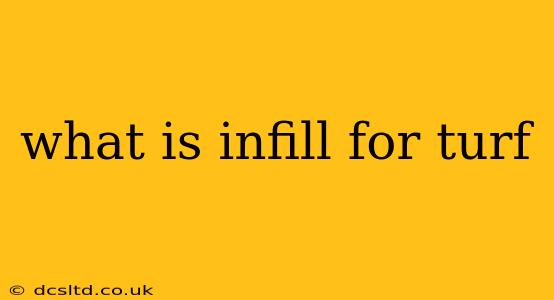Artificial turf, also known as synthetic turf, offers a durable and low-maintenance alternative to natural grass. However, to achieve its optimal performance and realistic look and feel, it needs infill. But what exactly is infill for turf? This comprehensive guide will explore everything you need to know about this crucial component of artificial turf systems.
What is Turf Infill?
Turf infill is a granular material placed between the artificial grass blades. It's not just filler; it plays a vital role in stabilizing the turf, improving its performance, and enhancing its overall appearance. Think of it as the "secret sauce" that transforms a synthetic lawn from a flat, plastic-looking surface into a lush, springy, and safe playing area.
What are the Different Types of Turf Infill?
Several types of infill materials are available, each with its own advantages and disadvantages:
1. Sand Infill:
Sand is a popular and cost-effective option. It helps with drainage and provides some stability, but it generally doesn't offer the same level of shock absorption or resilience as other infills.
2. Rubber Infill:
Derived from recycled rubber tires, rubber infill is the most common type. It provides excellent shock absorption, making it ideal for playgrounds and sports fields. However, concerns exist regarding potential exposure to harmful chemicals, although modern processing techniques have minimized this risk significantly. The crumb rubber used must adhere to stringent safety standards.
3. Zeolite Infill:
Zeolite is a natural mineral that offers excellent drainage and antimicrobial properties. It’s considered an environmentally friendly option and helps to reduce odor. However, it may be more expensive than sand or rubber.
4. Cork Infill:
Cork is a sustainable and renewable resource offering good shock absorption and drainage. It's softer than rubber, but may not be as durable for high-traffic areas.
What are the Benefits of Using Infill?
The benefits of using the right infill for your artificial turf are substantial:
- Enhanced Stability: Infill helps to keep the turf fibers upright, preventing matting and ensuring a consistent playing surface.
- Improved Drainage: Many infill materials, particularly sand and zeolite, facilitate better drainage, preventing waterlogging and creating a safer environment.
- Increased Shock Absorption: Rubber and cork infill significantly reduce the impact of falls, making the surface safer for children and athletes.
- Enhanced Aesthetics: Infill gives the turf a more natural and fuller appearance, reducing the plastic-like look of unfilled synthetic turf.
- Reduced Heat: Certain infills can help to lower the surface temperature of the turf, making it more comfortable to use in hot climates.
What is the Best Infill for My Needs?
Choosing the right infill depends on several factors, including:
- Intended Use: A playground will require different infill characteristics than a putting green. High-traffic areas need durable, resilient infill.
- Budget: Sand is the most economical choice, while zeolite and cork tend to be more expensive.
- Environmental Concerns: Zeolite and cork are considered more environmentally friendly options than rubber.
- Climate: Drainage is crucial in wet climates, making sand and zeolite good choices.
How Much Infill Do I Need?
The amount of infill required varies depending on the type of turf, pile height, and desired performance. Consult with your artificial turf installer for specific recommendations. Using the correct infill depth is crucial for optimal results. Too little and the turf will look sparse and uneven; too much and it may be overly dense, hindering drainage and making the surface less comfortable.
Is Infill Maintenance Required?
Yes, regular maintenance is recommended. This typically involves brushing the turf to redistribute the infill and remove debris. You may also need to top up the infill periodically to compensate for settling and loss over time.
What are the Environmental Considerations of Turf Infill?
The environmental impact of infill is a growing concern. Rubber infill, while common, raises questions about the potential release of microplastics and other pollutants. However, manufacturers are constantly developing more environmentally friendly options. Zeolite and cork are generally considered more sustainable choices. Consider the long-term environmental impact when making your decision.
This comprehensive guide should provide a solid understanding of infill for turf. Remember to consult with a professional installer to choose the best infill for your specific project and needs. By making an informed decision, you can ensure the longevity and performance of your artificial turf for years to come.
